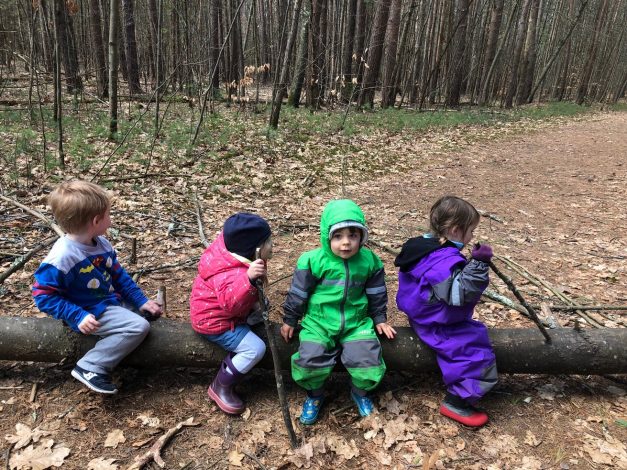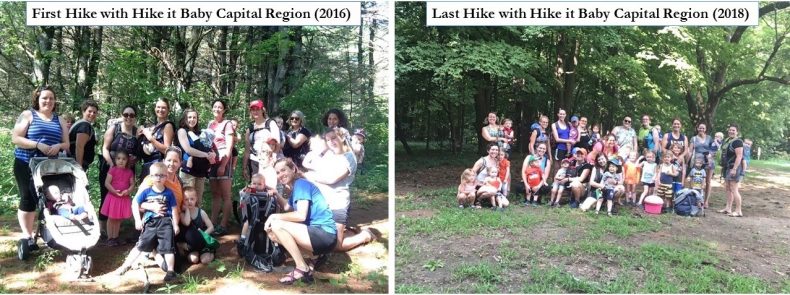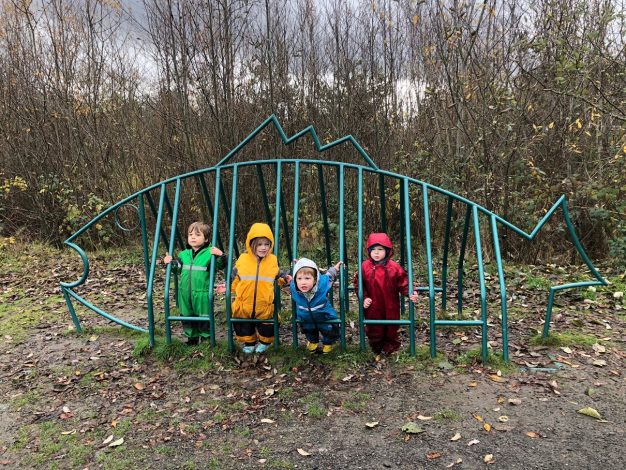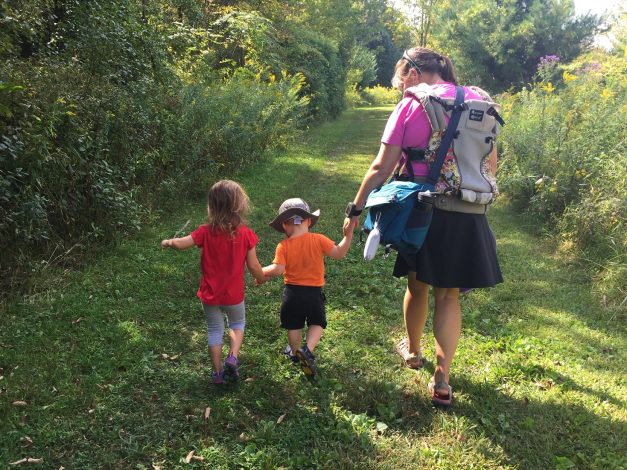How my Military Family Found our "Village" Through Hike it Baby
- Blog How my Military Family Found our "Village" Through Hike it Baby
When I met my husband, he was about three years into his career as a U.S. Navy submariner. I grew up with both parents serving in the military for over 20 years each, so I knew the life of a military spouse wasn’t for the faint of heart. Between the constant moving, the distance from family and the constant deployments, being a military family was stressful even before we became parents. By the time I became pregnant with our first baby, we knew we were nearing a change in duty station.
It turned out my husband’s transfer date was right at the end of my pregnancy. With this in mind, we made the hard decision for me to move from Southern Georgia to Upstate New York ahead of time. This would allow me to find a new doctor and settle in before the baby came. At 31 weeks pregnant, I said goodbye to the wonderful friends I had made in Georgia and headed north with my mom and a loaded SUV. By the time we made it to New York, I had terrible back pain. Assuming it was just from the time on the road in a car and pregnant belly, I didn’t think much of it.
However, my little dude had other ideas about his supposed “due date.” He decided to make his appearance at just under 32 weeks at a small hospital in Upstate New York while we were visiting family. Fast forward five months, my mom was back home in Colorado, my husband was working long hours on a rotating shift schedule and I was alone with a baby as a first-time mom. I had a really hard time with this new role of mother. I was also terrified to take my baby out into the world for long.
When I finally got the courage to get out, I found it difficult to connect with other moms. I felt as though they were either judging me based on my parenting style or leaving me out of a clique that had already formed between tight-knit groups that had known each other awhile. I felt like an outsider.
Finding Hike it Baby
That was when I came across a parenting group mentioned in one of the local Facebook pages I had joined: Hike it Baby. I was intrigued. Having spent a good chunk of my previous years in Colorado, I had always loved hiking and being out in nature. But how did one do that with a tiny baby? I joined the local branch’s Facebook group and followed along with the hike photos, hiking tips and conversations between the other members.
My little guy was about 8 months old before I got up the courage to join a hike. I remember being super nervous. I had no idea what I was doing and had already had poor experiences with other parenting groups. Fortunately, those nerves dissipated almost immediately when I reached the parking lot of my very first Hike it Baby adventure. Members automatically offered a smile, a hello and an offer to help get my little guy in his carrier. I was hooked from that first hike. I never felt judged, regardless of whether my parenting choices, background, views, etc., differed from others'.
Two years later, after I had attended and hosted countless hikes, I started a new sister Hike it Baby branch for the more northern members and enjoyed volunteering with an organization I believed in. My little guy was growing up as a Hike it Baby kid, and the outdoors had become both his and my happy place. In addition, we hiked with multiple other branches while on vacation and always felt that community wherever we went. We had found our village. 
Moving ... Again
Soon, we received news that our time in New York was coming to an end. While we were expecting this news, I was sad to leave our Hike it Baby family and the home we had made in New York. After we got orders, I did some research and found an active Hike it Baby branch at our new duty station: Hike it Baby Kitsap Peninsula in Washington State. I messaged the ambassadors from this branch and was relieved to feel that familiar welcome that I had become accustomed to from Hike it Baby. Regardless, I was still a bit nervous about having to start all over again in a new place with new people. What if it wasn’t a good fit for us? There was only one way to find out.  By the time we reached Washington, I was ready to get out and explore the nearby trails. I started attending hikes and hosting my own. I transferred my Branch Ambassador status to my new branch at the encouragement of the other BAs and took a stronger role in this new branch. Not only did my family find our new village almost immediately, but Hike it Baby members made the transition so much easier for all of us. While my 3-year-old still asked for some of his old friends, he also asked for some new friends he'd met in our new branch. He even enjoyed being my “co-host” on our hikes..
By the time we reached Washington, I was ready to get out and explore the nearby trails. I started attending hikes and hosting my own. I transferred my Branch Ambassador status to my new branch at the encouragement of the other BAs and took a stronger role in this new branch. Not only did my family find our new village almost immediately, but Hike it Baby members made the transition so much easier for all of us. While my 3-year-old still asked for some of his old friends, he also asked for some new friends he'd met in our new branch. He even enjoyed being my “co-host” on our hikes..
Another Baby on the way!
Four months after moving to Washington, I went into pre-term labor with my second child at just under 30 weeks. While they were able to slow down the birth process, I was stuck in a hospital an hour away while my husband was home with our little guy. Although I felt support from the military resources around us, it was our new Hike it Baby family who truly stepped in to help us out. My fellow BAs and other members of our branch didn’t hesitate to take over the hikes I had already scheduled. I got offers left and right to watch my son or help my husband with meals. I have never felt more of an outpouring of love from a community, especially after having only been here a short time!

Needless to say, I know that wherever the military sends us, I am confident that we'll have a community we can count on. That’s why I recommend Hike it Baby to all of the military families I encounter. Raising our kids to love the outdoors, no matter where that outdoors may be, and having a supportive, judgement-free environment has helped us cope with the many stressors that come with being a military family. When my husband deploys back out to sea later this year, I know that Hike it Baby will be there when the stress starts to feel unbearable. It takes a village to raise kids in today’s world, and I feel so fortunate that we have found that village in the Hike it Baby organization wherever we end up. 
Read More:
- How Hike it Baby Provides Connection for Military Families
- Join a hike: Find a family, be a community
- Hike it Baby: More than the trails, it's a community
How did you find Hike it Baby and how has it helped your family? Leave your comments below!
ABOUT OUTGROWN
OutGrown is a 501(c)(3) nonprofit that works to create a world where everyone can enjoy the physical and mental benefits of spending time outside. We are focused on creating opportunities and removing barriers to access so families with babies and young children can take their first steps outside. We believe all families have the right to connect with nature, benefit from spending time outdoors and be inspired to a lifelong love of nature. Since its grassroots inception in 2013, OutGrown is a growing community of 280,000 families and over 300 volunteer Branch Ambassadors. More information on all of our programs can be found at WeAreOutGrown.org
EDITORS NOTE:
We hope you enjoyed reading this article from OutGrown. We’re working hard to provide our community with content and resources that inform, inspire, and entertain you.
But content is not free. It’s built on the hard work and dedication of writers, editors, and volunteers. We make an investment in developing premium content to make it easier for families with young children to connect with nature and each other. We do not ask this lightly, but if you can, please make a contribution and help us extend our reach.
Related Content




Comments